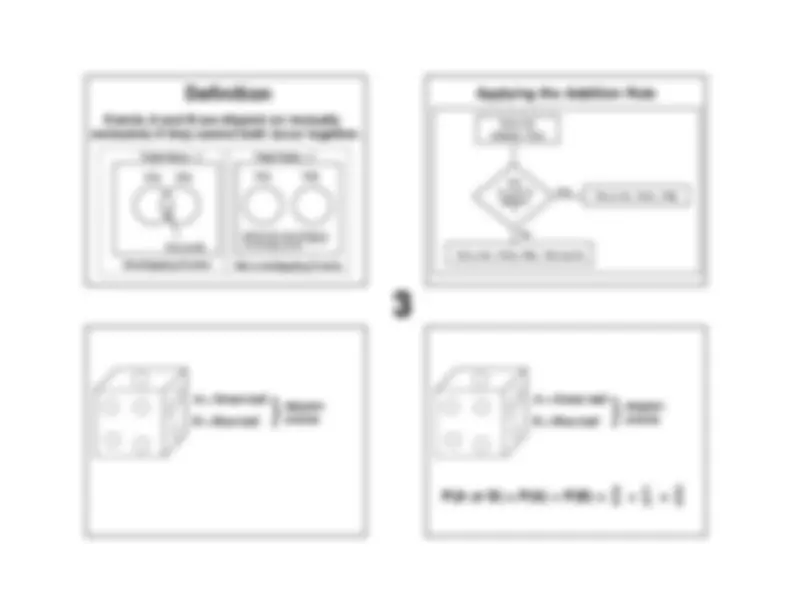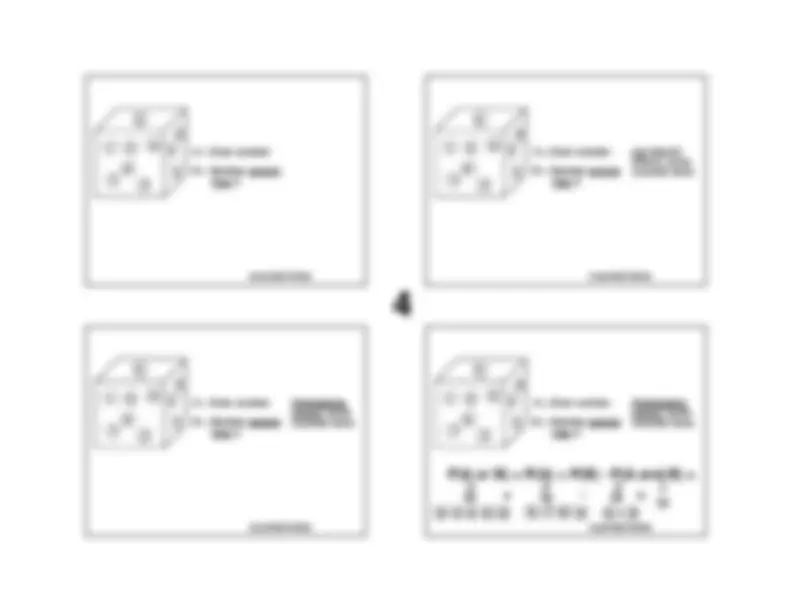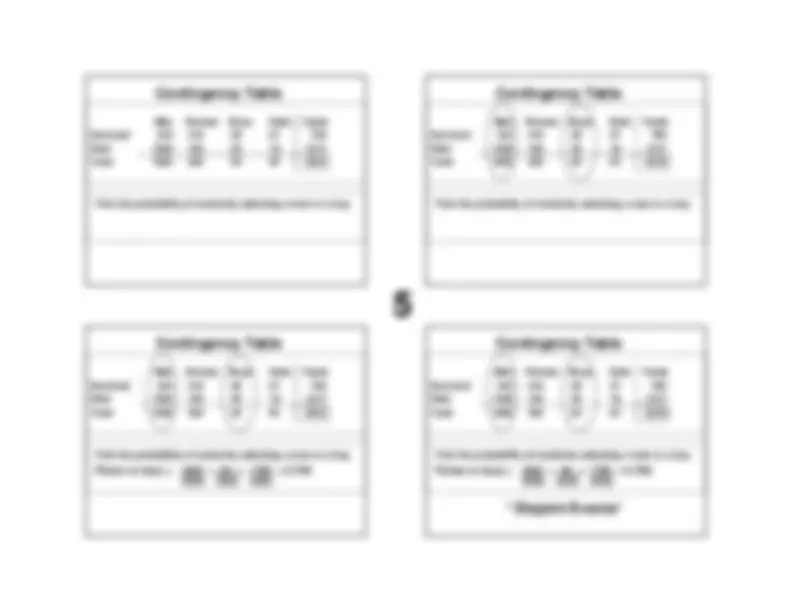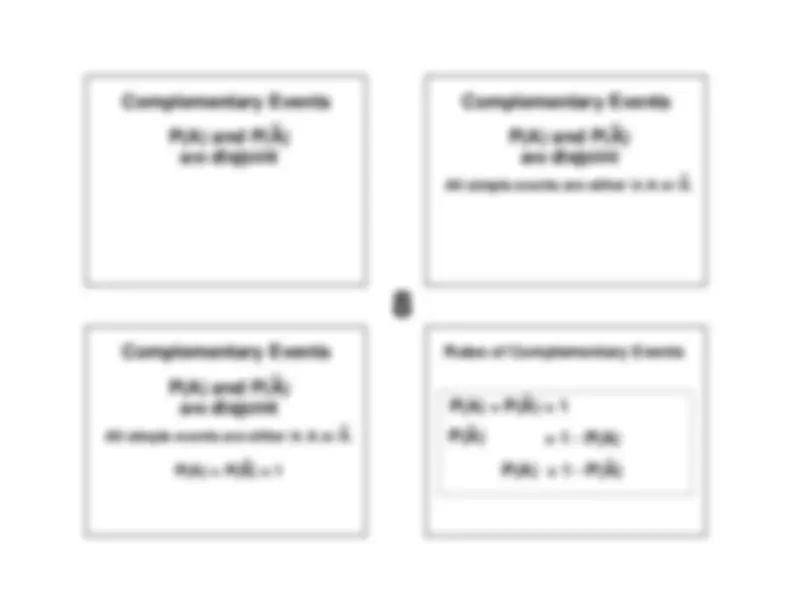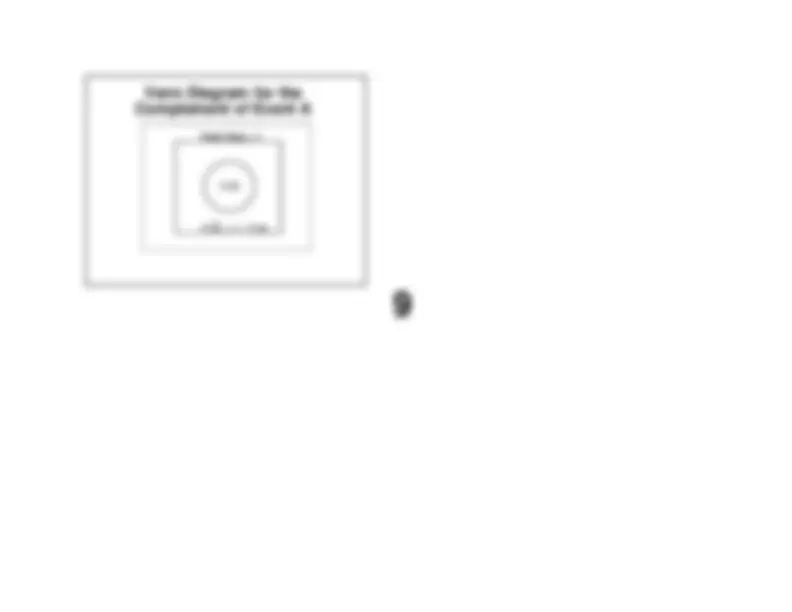Download Probability Theory: Addition Rule and Complementary Events and more Study notes Probability and Statistics in PDF only on Docsity!
3 3Addition Rule
Definition Compound EventAny event combining two or moresimple events
^ Compound EventAny event combining two or moresimple events ^ NotationP(A or B) = P (event A occurs or event B
Definition occurs or they both occur)
Compound EventGeneral RuleWhen finding the probability that event Aoccurs or event B occurs, find the totalnumber of ways A can occur and thenumber of ways B can occur, but find thetotal in such a way that no outcome iscounted more than once.
Compound EventFormal Addition RuleP(A or B) = P(A) + P(B) - P(A and B)where P(A and B) denotes the probability that A and Bboth occur at the same time.
Compound EventFormal Addition RuleP(A or B) = P(A) + P(B) - P(A and B)where P(A and B) denotes the probability that A and Bboth occur at the same time.Intuitive Addition RuleTo find P(A or B), find the sum of the number of waysevent A can occur and the number of ways event B canoccur, adding in such a way that every outcome iscounted only once. P(A or B) is equal to that sum,divided by the total number of outcomes.
DefinitionEvents A and B are disjoint (or mutuallyexclusive) if they cannot both occur together.
DefinitionEvents A and B are disjoint (or mutuallyexclusive) if they cannot both occur together.Total Area = 1P(A) P(B) P(A and B)Overlapping Events
0 counted twice 6 5 214 A = Even number 8 B = Number greater^97 than 5^3
0 counted twice 6 5 214 A = Even number 8 B = Number greater^973
not disjointevents; somecounted twicethan 5
0 counted twice 6 5 214 A = Even number 89 B = Number greater 73
Overlappingevents; somecounted twicethan 5
P(A or B) = P(A) + P(B) - P(A and B) =^45 +^ -^ =^1010
6 5 0214 A = Even numberOverlappingevents; some 89 B = Number greatercounted twice 7 than 5^37 8 &^9 6 8 counted twice
Men^ Women Find the probability of randomly selecting a man or a boy. Boys^ Girls^ Totals Survived^332
Died^1360
Total^1692
Contingency Table^64 45
Men^ Women Find the probability of randomly selecting a man or a boy. Boys^ Girls^ Totals Survived^332
Died^1360
Total^1692
Contingency Table^64 45
Find the probability of randomly selecting a man or a boy.P(man or boy) =^ 1692 + 64 = 1756 = 0.790^2223
Men^ Women^ Boys^ Girls^ Totals^2223
Survived^332
Died^1360
Total^1692
Contingency Table^64 45
Find the probability of randomly selecting a man or a boy.P(man or boy) =^ 1692 + 64 = 1756 = 0.790^2223
Men^ Women^ Boys^ Girls^ Totals^2223
Survived^332
Died^1360
Total^1692
Contingency Table^64 45 2223 * Disjoint Events*
Find the probability of randomly selecting a man orsomeone who survived.P(man or survivor) =^
1692 +^ 706 -^ 332 = 2066 2223 2223 2223
Men^ Women^ Boys^
Girls^ Totals Survived^332
Died^1360
Total^1692
Contingency Table^64 45 2223 = 0.929* Overlapping Events *
Setting up a Contingency TableExample: In a test of the allergy drug Seldane, 49 of 781users experienced headaches, 49 of 665 placebo usersexperienced headaches, and 24 of 626 people in thecontrol group experienced headaches.
Setting up a Contingency TableExample: In a test of the allergy drug Seldane, 49 of 781users experienced headaches, 49 of 665 placebo usersexperienced headaches, and 24 of 626 people in thecontrol group experienced headaches.Headache^49
49 24 122 No Headache^732
616 602 1950 Totals^781 Seldane^ Placebo^ Control Group^665
Setting up a Contingency TableExample: In a test of the allergy drug Seldane, 49 of 781users experienced headaches, 49 of 665 placebo usersexperienced headaches, and 24 of 626 people in thecontrol group experienced headaches.Headache^49
49 24 122 No Headache^732
616 602 1950 Totals^781 Seldane^ Placebo^ Control Group^665 626
Complementary EventsP(A) and P(A)are^ disjoint
Complementary EventsP(A) and P(A)are^ disjointAll simple events are either in A or A.
Complementary EventsP(A) and P(A)are^ disjointAll simple events are either in A or A.P(A) + P(A) = 1
Rules of Complementary EventsP(A) + P(A) = 1P(A)= 1 - P(A)P(A) = 1 - P(A)

